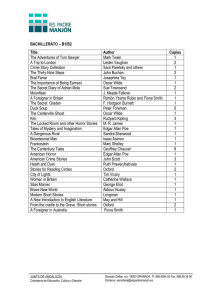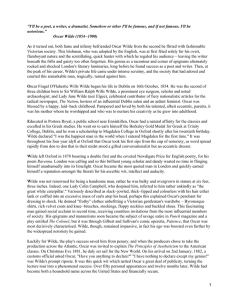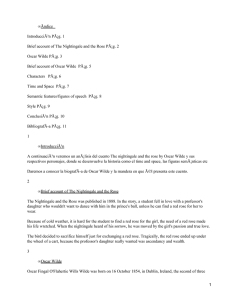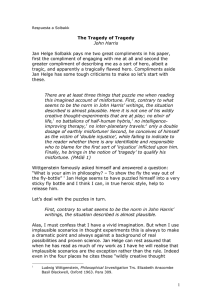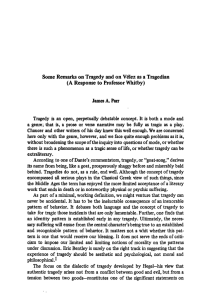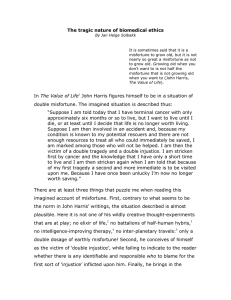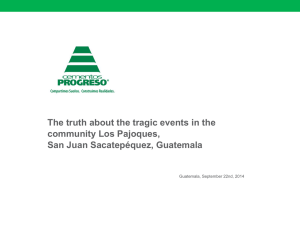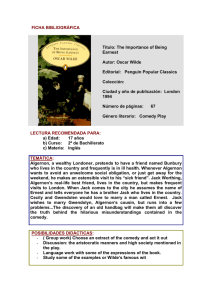THE TRAGIC MODE IN OSCAR WILDE`S FAIRY TALES DÉBORAH
Anuncio
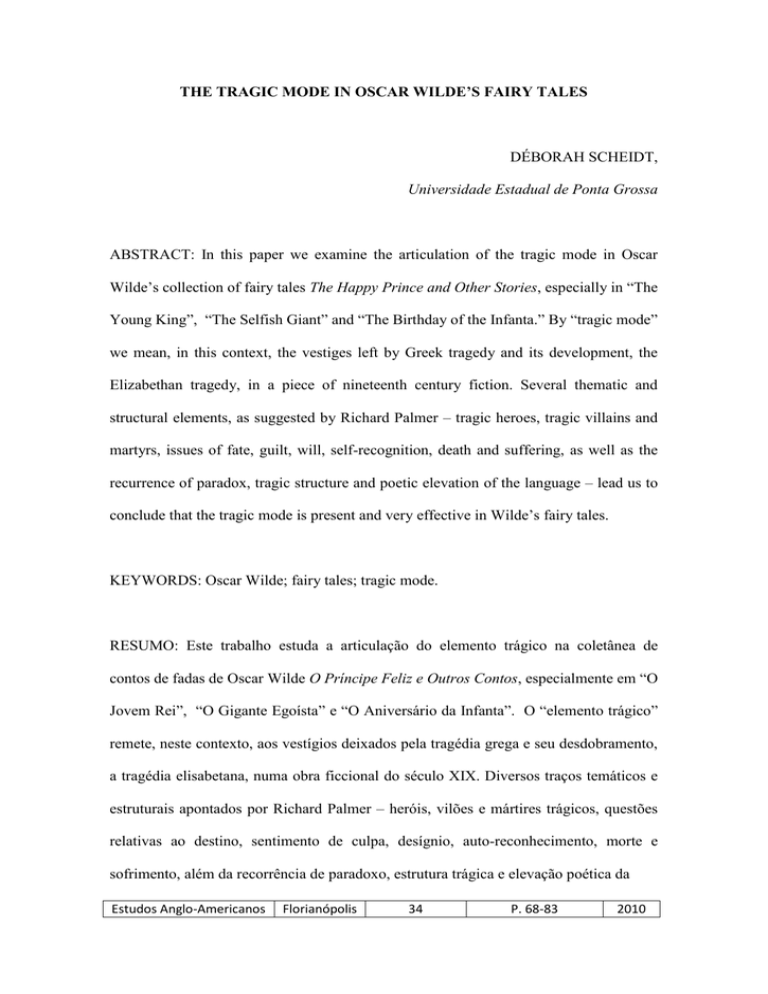
THE TRAGIC MODE IN OSCAR WILDE’S FAIRY TALES DÉBORAH SCHEIDT, Universidade Estadual de Ponta Grossa ABSTRACT: In this paper we examine the articulation of the tragic mode in Oscar Wilde‟s collection of fairy tales The Happy Prince and Other Stories, especially in “The Young King”, “The Selfish Giant” and “The Birthday of the Infanta.” By “tragic mode” we mean, in this context, the vestiges left by Greek tragedy and its development, the Elizabethan tragedy, in a piece of nineteenth century fiction. Several thematic and structural elements, as suggested by Richard Palmer – tragic heroes, tragic villains and martyrs, issues of fate, guilt, will, self-recognition, death and suffering, as well as the recurrence of paradox, tragic structure and poetic elevation of the language – lead us to conclude that the tragic mode is present and very effective in Wilde‟s fairy tales. KEYWORDS: Oscar Wilde; fairy tales; tragic mode. RESUMO: Este trabalho estuda a articulação do elemento trágico na coletânea de contos de fadas de Oscar Wilde O Príncipe Feliz e Outros Contos, especialmente em “O Jovem Rei”, “O Gigante Egoísta” e “O Aniversário da Infanta”. O “elemento trágico” remete, neste contexto, aos vestígios deixados pela tragédia grega e seu desdobramento, a tragédia elisabetana, numa obra ficcional do século XIX. Diversos traços temáticos e estruturais apontados por Richard Palmer – heróis, vilões e mártires trágicos, questões relativas ao destino, sentimento de culpa, desígnio, auto-reconhecimento, morte e sofrimento, além da recorrência de paradoxo, estrutura trágica e elevação poética da Estudos Anglo-Americanos Florianópolis 34 P. 68-83 2010 linguagem – fazem-nos concluir que o elemento trágico está presente e é bastante contundente nessa obra de Wilde. PALAVRAS-CHAVE: Oscar Wilde; contos de fadas; elemento trágico. Wilde also told his sons all his own written fairy stories. Cyril once asked him why he had tears in his eyes when he told them the story of “The Selfish Giant”, and he replied that really beautiful things always made him cry. (Vyvyan Holland, apud PEARCE, 2000, p. 219) Story after story readers are deeply moved – sometimes, like the author himself, even to tears – as they make their way through Oscar Wilde‟s The Happy Prince and Other Stories, the collection of his two volumes of fairy tales The Happy Prince (1888) and A House of Pomegranates (1891). But this is not the type of emotion that we might experience with traditional fairy tales as, ultimately, we come across a romantic kiss or a happy outcome following a succession of adversities. In Wilde‟s tales the tears are due to what is (apparently) a complete subversion of the “lived happy ever after” formula, to the extent that, with the exception of “The Young King”, all the other eight tales end in the death of the protagonist. Critics have repeatedly pointed out the pessimism of Wilde‟s approach to fairy tales as a result of his admiration for Schopenhauer‟s philosophy (Pearce, 2000, p. 82) or, more generally, his outlook on life as being “almost uniformly bitter”. (Carpenter & Prichard, 1999, p. 238) The negative vein in his stories is also often connected with Wilde‟s 1891 famous essay “The Soul of Man under Socialism”, inasmuch as they denounce the disregard of the higher social classes and of the intellectual elite for the poor. (Woodcock, 1950, p. 147-148; Kileen, 2007, p. 63-64) Virtually all the stories present this issue, which is, however, more directly addressed in “The Young King”, the tale of a boy born of an illicit relationship between a princess and someone below her status. Oedipian overtones immediately come to mind when we hear that the boy had been “when but a week old, stolen away from his mother‟s side, as she slept, and given to the charge of a common peasant and his wife” (Wilde, 1994, p. 78i). Most relevantly, though, is the fact that at the age of sixteen he comes to the painful realization that his royal status is only preserved at the cost of the suffering and death of many of his vassals. This recognition happens in the eve of his coronation, and it takes the shape of three ominous dreams, which expose the normally invisible hard labour behind the opulence of the festivities. The first dream is about the work of the “pale, sickly-looking children” (p. 83) in charge of weaving the cloth for the new king‟s robe. The second one reveals the death of the black slaves who fish for pearls for the royal sceptre. The last dream is in morality-play style as it depicts Death and Avarice‟s battle over the lives of the men digging and cleaving rocks for rubies for the king‟s crown. At his coronation ceremony, the prince, formerly a vain teenager who had worried only about his “delicate raiment and rich jewels” (p. 79), shocks everyone when he is seen wearing “the leathern tunic and rough sheepskin cloak that he had worn when he had watched [...] the goatherd [...] and in his hands he took his rude shepherd‟s staff.” (p. 92) But could we call the prince‟s experience as tragic, or merely sad? Richard Palmer (1992, p. 2) calls our attention to the present-day complexities involving the term “tragedy”. In 2400 years of usage, its meaning (that even in Aristotle‟s time was never established conclusively) has become highly disputed, along with the possibility of its contemporary existence. Diametrically opposed approaches live side-by-side, from the utter banalisation of the term (e.g. by the media) to critics who claim that only a few selected plays can be rightfully called tragedies. Palmer attempts (1992, p. 10) to cast some light on the matter by defending the idea that the tragic experience depends on the reader‟s / spectator‟s response: “Tragedy is a dramatic form that stimulates a response of intense, interdependent, and inseparably balanced attraction and repulsion.” The “beauty that makes one cry” from the epigraph would be one way to put it. Still according to Palmer (1992, p. 21) this tragic response could arise from a variety of recurring features such as several categories of hero (including collective, anti- and proletarian), tragic villains and martyrs, issues of fate, guilt, will, self-recognition, death and suffering, paradox, tragic structure and poetic elevation. A number of these recur in Wilde‟s stories and we shall adopt the expression “tragic mode” to refer to them. Thus, although the protagonist of “The Young King” does not die (like some heroes in classical tragedy), the tragic mode in that particular story lies in its strong element of self-recognition, following the protagonist‟s realization of his excessive self-centredness (which, for most authors, is what the Greek called hybris), as well as in the poetic elevation through which this new awareness is materialized. The following table points at some of the dominant tragic features of each story: Tragic feature Stories Self-recognition “The Young King”; “The Star-Child”;“The Selfish Giant” Anti-hero “The Fisherman and his Soul” Tragic villain “The Remarkable Rocket” “The Happy Prince”;“The Nightingale and the Rose”; “The Martyrs Devoted Friend” Death All stories, except for “The Young King” Suffering All stories Tragic structure “The Selfish Giant” “The Happy Prince”;“The Nightingale and the Rose”;“The Paradox Birthday of the Infanta”; “The Devoted Friend” Poetic elevation All stories Of course, in a deeper analysis, many other more subtle materializations of the tragic mode could be found in the tales. A story that deserves particular attention regarding the presence of the tragic mode is “The Selfish Giant”, perhaps Wilde‟s best loved fairy tale and the one with the clearest tragic characteristics. Like the traditional tragic heroes, the protagonist has a high status and a great deal of power, as well as a tragic flaw analogous to hybris, which is evidenced both in the Giant‟s actions and – very ostensibly – in the repetition of the word “selfish” over and over along the text, starting from the title. The traditionally Greek tragic pattern of “purpose, passion and perception” (Tennyson, p. 63) can be very clearly detected at the same time as, structurally, the story follows the “well-built” Elizabethan tragedy scheme known as Freytag‟s pyramid (Freytag, 1900, p. 115). The first paragraphs present the children and the garden, standing for the exposition, or act I of a five-act play. The exciting force (the arrival of the Giant, the owner of the garden) sets the rising action or complication in motion (act II of an Elizabethan tragedy): there is a conflict between the protagonist and the children, who are sent away from the garden. The Giant builds a high wall to protect his property. Tension builds up when Spring visits every corner of the kingdom, except for the Giant‟s garden. Such conflict is beautifully portrayed in personified weather phenomena: Only in the garden of the Selfish Giant it was still winter. The birds did not care to sing in it as there were no children, and the trees forgot to blossom. [...]The only people who were pleased were the Snow and the Frost. [...] The Snow covered up the grass with her great white cloak, and the Frost painted all the trees silver. Then they invited the North Wind to stay with them, and he came. He was wrapped in furs, and he roared all day about the garden, and blew the chimney-pots down. "This is a delightful spot," he said, "we must ask the Hail on a visit." So the Hail came. Every day for three hours he rattled on the roof of the castle till he broke most of the slates, and then he ran round and round the garden as fast as he could go. He was dressed in grey, and his breath was like ice. Climax, also known as turning point (act III) coincides, in this story, with the anagnorisis, or recognition of the truth, an insight into oneself that allows for the dignity and nobility of the protagonist‟s end. This occurs when the Giant realizes that his own actions have been the cause of nature‟s revolt against his garden. The weather change signalling renewal is both external and internal: “And the Giant‟s heart melted as he looked out. „How selfish I have been!‟, he said.” (p. 36) The falling action stage of the story (act IV) happens in fast-forward rhythm, as the years go by and the giant, now gentle and sociable, is too old to play with the children and just sits happily in his “huge armchair”, watching their games and the succession of seasons, now peacefully accepting winter, as “he knew that it was merely the Spring asleep.” (p. 38) This is the point in which a traditional children‟s writer would fit the “and they lived happily ever after” dictum. However, the tragic mode of this story demands a denouement (or act V). But just before that stage, we observe what Freytag calls “the force of the last suspense” which is a feature of a few tragedies: the little boy reappears unexpectedly, with marks of two nails on his hands and feet, a complicating factor that leads to a beautiful and very poignant ending: Who hath dared to wound thee?" cried the Giant; "tell me, that I may take my big sword and slay him." "Nay!" answered the child; "but these are the wounds of Love." "Who art thou?" said the Giant, and a strange awe fell on him, and he knelt before the little child. And the child smiled on the Giant, and said to him, "You let me play once in your garden, today you shall come with me to my garden, which is Paradise." And when the children ran in that afternoon, they found the Giant lying dead under the tree, all covered with white blossoms. (p. 39) Taking the collection as a whole, this is the story in which the metaphysical character of tragedy finds its strongest echo. The blatant Christian (or more specifically, Catholic reference, in its graphic emphasis of the wounds of Christ) is taken from Luke (23:43) and re-enacts the moment of the crucifixion in which Christ promises salvation to the repentant thief. This scene, according to Jarlath Kileen (2007, p. 62) also brings new light to the previous episode in which the Giant had picked up the boy and placed him on the tree, reminding us of Saint Christopher, who is usually represented as a giant, carrying the Holy Child on his shoulder. The fact that the Giant is both the owner of the Garden and the one who expels the children from it, also points at his Old Testament God-like stance. (Kileen, 2007, p. 75) But Kileen (2007, p. 63) also tells us of an alternative mythical interpretation based on the fact that giants and ogres are versions of the “terrible father”, Kronos, who devoured his own children. This would refer to a father who does not fulfil his paternal duties, but quite on the contrary, represents peril to his children – maybe Wilde sensing the onus of his lifestyle on his family and foreseeing his, as well as their, tragic ending? But not all theoreticians think that tragedy should, no matter how awe-inspiring, ultimately reaffirm one‟s faith in life. George Steiner, for example, strongly opposes the trivialisation and the uncritical use of the term. For him, very few plays can be actually classified as tragedies and the real tragic world-view is best summarized in the following way: “It is best not to be born, next best to die young.” This dictum [...] entails the view that human life per se, both ontologically and existentially, is an affliction. That non-existence or early extinction are urgent desiderata. The proposition implies that men and women's presence on this earth is fundamentally absurd or unwelcome, that our lives are not a gift or a natural unfolding, but a self-punishing anomaly. We are unwelcome guests, old enough at the moment of birth (as Montaigne says) to be a corpse and blessed only if this potentiality is realized as swiftly as it can be. (Steiner, 1998, p. 535) Perhaps the tale that comes closest to this existentialist view of tragedy is “The Birthday of the Infanta”, ironically, the one that has the word “birth” in its title. Indeed, a considerable part of the narrative is devoted to describing – in Wildean splendorous detail – the Infanta of Spain and the Indies‟ twelfth birthday party, including the luxurious palace settings, the “stately grace” (p. 100) of the princess and her guests and, most importantly, the party‟s colourful entertainment: a mock bull-fight, an Italian tragic puppet performance, gipsy musicians with performing monkeys... Only then are we introduced to the protagonist, a malformed dwarf who had been discovered in the forest in the previous day by hunters and was brought to the palace to dance for the Infanta: Perhaps the most amusing thing about him was his complete unconsciousness of his own grotesque appearance. Indeed he seemed quite happy and full of the highest spirits. When the children laughed, he laughed as freely and as joyously as any of them, and at the close of each dance he made them each the funniest of bows, smiling and nodding at them just as if he was really one of themselves, and not a little misshapen thing that Nature, in some humourous mood, had fashioned for others to mock at. (p. 110) His fascination is immediate and he cannot take his eyes off the girl, so he‟s thrilled by the invitation to go back to the palace the next day, to perform for her again. His delight is commented, chorus-style, by the palace flower gardens: 'He is really far too ugly to be allowed to play in any place where we are,' cried the Tulips. 'He should drink poppy-juice, and go to sleep for a thousand years,' said the great scarlet Lilies, and they grew quite hot and angry. 'He is a perfect horror!' screamed the Cactus. 'Why, he is twisted and stumpy, and his head is completely out of proportion with his legs. Really he makes me feel prickly all over, and if he comes near me I will sting him with my thorns.' (p. 112) This judgemental attitude continues in the speeches of the White Rose Tree, the Geraniums and the Violets, approximating the characterization of the group of flowers to that of the Greek chorus, as one the many functions of the chorus is to interpret the conflict from a collective perspective, as opposed to the individuality of the hero‟s stance, reinforcing the fact that in the tragic mode the protagonist, alone, is up against inescapable powers. Furthermore the hint at eternal sleep and injury by thorn predicts the (Christianized) tragic fate of the dwarf. Accordingly, foreseeing the catastrophe is another of the many functions of the Greek chorus. But unaware of the ill disposition of the flowers towards himself, the dwarf happily fantasizes about what he judges to be his first human friend: “How he wished that he had gone back with her! She would have put him on her right hand, and smiled at him, and he would have never left her side, but would have made her his playmate, and taught her all kinds of delightful tricks.” (p. 117) The moment of self-realization approaches as, on the next day, amazed at the luxury of the empty palace, he roams room after room, a white rose intended as a present in hand, in search of the Infanta, until in one of them he finds a strange “invisible wall of clear water” (p. 124) and takes a few minutes to realize that it mocks every single movement of his. Eventually, [w]hen the truth dawned upon him, he gave a wild cry of despair, and fell sobbing to the ground. So it was he who was misshapen and hunchbacked, foul to look at and grotesque. He himself was the monster, and it was at him that all the children had been laughing, and the little Princess who he had thought loved him - she too had been merely mocking at his ugliness, and making merry over his twisted limbs. “Why had they not left him in the forest, where there was no mirror to tell him how loathsome he was?” Why had his father not killed him, rather that sell him to his shame? The hot tears poured down his cheeks, and he tore the white rose to pieces. The sprawling monster did the same, and scattered the faint petals in the air. It grovelled on the ground, and, when he looked at it, it watched him with a face drawn with pain. He crept away, lest he should see it, and covered his eyes with his hands. He crawled, like some wounded thing, into the shadow, and lay there moaning. (p. 125) Catastrophe quickly ensues followed by the arrival of the Infanta and her complaint that her “funny little dwarf is sulking.” (p. 126) To the Chamberlain‟s diagnosis that the “petit monster” will never dance again “[b]ecause his heart is broken”, the Infanta replies, frowning: “For the future, let those who come to play with me have no hearts.” (p. 127) To pick up from where we left George Steiner‟s theories on the “pure or absolute mode of tragedy” the dwarf‟s attitude in questioning his fate followed by his death (that we could even consider, to all intents and purposes, a willing refusal to go on living), seems to prove that [a] “normal” life-span, let alone old age, are sadistic misfortunes. It follows that the engendering of children, the willed continuation of human beings, is folly or deliberate cruelty. It follows also – and this is a key issue – that suicide is both logical and economically advantageous in the root sense of the word “economic”. Or to cite Camus: “suicide is the only serious philosophic question”. (Steiner, 1998, p. 535) The dwarf‟s death/suicide is directly related to the contemplation of his – until the visit to the palace, unknown – physical “inhumanity”, which the essential goodness and nobility of his character is not able to offset in a world ruled by materialism and appearances. The scene of the mirror at the end of the story aptly brings to the concrete level a process of mirror/foil characterization that had been happening all along the narrative: both the Infanta and the dwarf are extremely lonely children, the Infanta for not normally being allowed to play with anyone “below her rank” and the dwarf, for living in isolation in the forest, having as his companions only birds and lizards; both are motherless and largely ignored by their fathers. Indeed, when the dwarf first sees his own image in the palace‟s mirror, he at first thinks that that is the Infanta who is coming to receive him: “The Infanta! It was a monster, the most grotesque monster he had ever beheld.” (p. 123) This perception, if not accurate for what it implies on physical terms, is exact to describe the inner nature of the Infanta, implied at the beginning of the story and laid bare at the end: her utter insensitivity and inability to see the other – her hybris, in the sense of “deliberate infliction of serious insult on another human being”, which, according to Fisher (1997, p. 46) is the real and traditional meaning of the word. Tragic paradox, here, reveals the dynamics of social evaluation based on external appearances to the exclusion of internal worth. The extremely bitter outlook of this tale seems to confirm Carpenter and Princhards‟s observation that if Wilde read the stories from the first volume of fairy tales (where “The Selfish Giant” was originally published) to his own children, the second volume (where we can find the Infanta‟s story) “made no pretense of being for children.” (1999, p. 238) Thus, different intensities of the tragic mode orient Wilde‟s view of tragedy and these varying “shades of darkness” are represented by the three stories more closely studied in this work, especially by their endings. Rather than a traditional happy ending, the final paragraphs of “The Young King” suggest openness: [T]he glory of God filled the place [...] “and the people fell on their knees in awe, [...] and the Bishop‟s face grew pale. [...]“A greater than I hath crowned thee,” he cried. [...] And the Young King came down from the high altar , and passed home from the midst of the people. But no man dared look upon his face, for it was like the face of an angel. (p. 97) Ultimately, they have, however, an optimistic air, as the changes operated within the character are deep and pervading, pointing at a promising future as a king. In a way, “The Star Child” could also fall into this category, as there is a similar movement towards maturity and when the protagonist becomes a king, “there is peace and plenty in the land” due to his generosity. However the last paragraph of the story undoes the optimistic note as, due to the hero‟s suffering, “after the space of three years he died and he who came after him ruled evilly.” (p. 204) The death of the protagonist in “The Selfish Giant” only apparently suggests a subversion of the traditional happy ending. The physicality of the Giant‟s body lying dead under the tree is counteracted by the promise of eternal life made by the boy Jesus and materialized by the white blossoms that cover the body. This story is emblematic of the ambiguous feeling pointed out by Northrop Frye (1966, p. 36) as the effect of tragedy: “Tragedy is a paradoxical combination of a fearful sense of rightness and a pitying sense of wrongness.” The same approach seems to operate in “The Happy Prince” and to a lesser extent, in “The Nightingale and the Rose” and “The Devoted Friend”. The death of the protagonist, however, does not seem to reinforce the meaning of life at all in “The Birthday of the Infanta”, perhaps the darkest and most existentialist story in the whole collection. The stories in the collection are little tragic jewels, or “literary expressions of the tragic sense of life, probing the nature of man and illumining dark facets of experience.” (Kingston 1974, p. 168) They do so by addressing “a darker, more pessimistic sensibility” (Thacker and Webb, 2002, p. 74) and by audaciously bringing forth appalling facts of life, such as social differences, cruelty, hypocrisy, rejection, and, of course, death itself. The fact that they are targeted both at adults and children comes to prove that Wilde is never condescending (to either age-groups) and that, in inserting a genre previously undervalued as “children‟s matter” into the high culture tradition, he is, as in other of his literary achievements, a precursor of modernity. REFERENCE CARPENTER, Humphrey & PRICHARD, Mary. The Oxford Companion to Children’s Literature. Oxford: OUP, 1999. FISHER, Nick. Hybris, Status and Slavery. In: POWELL, Anton (ed.) The Greek World. New York: Routledge, 1997. FREYTAG, Gustave. Technique of the Drama: An Exposition of Dramatic Composition and Art. Chicago: Scott, Foresman and Company, 1900. Available online on http://www.archive.org/stream/freytagstechniqu00freyuoft#page/114/mode/2up. Access Aug. 25, 2010. FRYE, Northrop. Anatomy of Criticism. New York: Atheneum, 1966. KILEEN, Jarlath. The Fairy Tales of Oscar Wilde. Aldershot (England): Ashgate, 2007. KINGSTON, Carolyn. The Tragic Mode in Children’s Literature. New York: Teachers College Press, 1974. PALMER, Richard. Tragedy and Tragic Theory: An Analytical Guide. Westport: Greenwood Press, 1992. PEARCE, Joseph. The Unmasking of Oscar Wilde. London: Harper Collins, 2000. SZELISKI, John V. Tragedy and Fear: Why Modern Tragic Drama Fails. Chapel Hill, NC: University of North Carolina Press. 1971 STEINER, George. Tragedy Pure and Simple. In: SILK, M. S. (ed.) Tragedy and the Tragic: Greek Theatre and Beyond. Oxford: OUP, 1998. TENNYSON, G. B. An Introduction to Drama. New York: Holg, Rinehart and Whinstron, 1966. WILDE, Oscar. The Happy Prince and Other Stories. London: Penguin, 1994. WOODCOCK, George. The Paradox of Oscar Wilde. New York: Macmillan, 1950. ZIPES, Jack. “Oscar Wilde‟s tales of illumination.” In: When dreams come true. London: Routledge, 1999. i All the references to the texts of the fairy tales henceforth are from the same edition.
